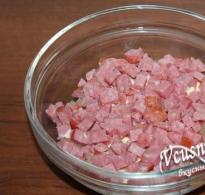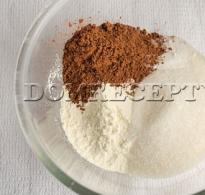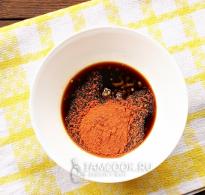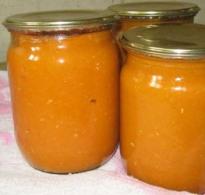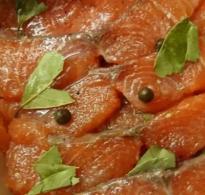Starch content in zucchini. Starch-rich foods
Despite the fact that starch is included in small quantities in all vegetables, we know much less about this substance than we should. Let's talk about the benefits and dangers of starch, about what types of this carbohydrate are and what foods are the most starchy.
What few probably know about is that starch can be beneficial or even harmful. By default, foods containing starch are considered to have an increased glycemic index, that is, they are absorbed quickly and contribute to an increase in blood glucose levels.
However, not all starch is created equal. There is starch that is absorbed quickly, that is absorbed slowly, and even that is not absorbed at all.
What it depends on and how to determine which one is better, I will try to explain it simply and clearly in this material.
What is starch and its role in human nutrition
Starch is a complex carbohydrate. For a long time, it was believed that complex carbohydrates were less likely to raise blood glucose levels than various types of sugars. However, practice has shown that some types of starch have an even higher glycemic index than sugar.

People who are forced to monitor blood sugar levels should also give up foods containing starch, as it breaks down very quickly and turns into glucose.
Which starch is absorbed quickly and which is slow?
First of all, let's remember that starch is found in varying amounts in all fruits and vegetables. It's just that somewhere there is a lot of it, but somewhere there is very little.
Here's what's really important: The speed of assimilation of starch depends on the degree of processing of the products.
All grains and legumes are very rich in this carbohydrate, but grinding wheat, for example, into flour, making bread and buns from it, we facilitate the absorption of starch. Thus, breads and pastries can raise blood sugar levels in minutes, even if no traditional granulated sugar has been added to the recipe.
The starch with the highest glycemic index, exactly the one that is contained in white bread, pastries. Conversely, whole grain bread contains less "quick starch", is more difficult to digest, and even some of it is not digestible. This starch is called resistant starch and can lower blood glucose levels after hyperglycemia.
Interesting fact! One of the foods that contains starch, but takes a long time to digest, is pasta. But not any, but high-quality pasta prepared "al dente", that is, not quite to the end. It turns out that the starch molecules are so tightly packed in the paste that only half of them are absorbed instantly.
What is the healthiest starch?
- Dietitians consider beans and lentils to be the best sources of the "right" starch;
- In second place are whole grains, such as, for example, buckwheat, brown rice, quinoa, amaranth, oats.
- If glucose is an important indicator for you, then try to eliminate all foods from white flour from your diet altogether.
- Also, breakfast cereals are a source of bad starch.
What are the benefits and harms of starch?
Many people say that starch is a very useful substance, since it is nutritious, this is so. The body also needs glucose. However, you need to be aware that every spike in blood glucose is always a load on the cardiovascular system.
It just means that everything must be followed by the norm. The body needs starch, as it turns into glucose, which from the blood enters the cells and feeds them. An unnecessary stress on the cardiovascular system occurs only when the cells are already oversaturated with glucose and the blood sugar level is still high.
Resistant starch is believed to be very important in the prevention of cancer. It is found in potatoes and fresh fruits and vegetables and legumes.
On the other hand, easily digestible starch can cause significant harm to health. Abuse of white bread, sweet pastries, can lead to very serious diseases, especially with regard to the cardiovascular system. Pancreas problems are not excluded. After all, every time the glucose level rises sharply, then it produces more insulin. If such surges are a constant phenomenon, it cannot but increase health risks.

Starchy foods
As you already understood, starch is found in all fruits and vegetables. The only difference is that where starch is negligible, it is simply considered that it does not exist, since the volumes are so insignificant that it is even difficult to call it a content, it would be more correct to “have traces of starch”.
Plant foods that contain the most starch:
- Beans
- Lentils
- Potato
- Corn
- Buckwheat
- Potato sweet potato
- Amaranth
Low starch foods:
- Carrot
- Beet
- Eggplant
Non-starchy vegetables:
- Cucumbers
- Leaf salad
- Spinach
- Bell pepper
- Sorrel
- Cabbage
- A tomato
Are there starch in apples?
There is. Only the amount of starch depends on the variety and ripeness. An apple with less sweetness tends to have more starch than sugars.
Starch is a necessary carbohydrate, but only when the measure in use is observed, as in everything, however. Starchy foods are a sure way to get an extraordinary dose of energy, and this is what starch is valuable for. Nevertheless, I recommend that you listen to the opinion of experts, and limit, if possible, the consumption of rapidly digestible starch in order to reduce the risk of developing diseases of the cardiovascular system.
Eat right and be healthy!
We are used to thinking that any vegetables are good for weight loss. But some sources divide all products into starchy and non-starchy vegetables. And other diets or advisors prohibit eating starchy vegetables at all. Well, who has not heard in our time that for the sake of your dream you will have to give up beets or carrots, throw potatoes and part with sweet potatoes? However, starchy vegetables should not be ruled out in all cases. It is necessary to carefully select a diet for weight loss, and take into account your own needs and preferences.
Starchy and non-starchy vegetables and why they are divided
Traditional diet number eight had no such thing as starchy vegetables. She recommended only limiting potatoes and pasta in the diet of losing weight. The term itself appeared somewhat later. Historically, American naturopathic doctors of the early 20th century were the first to use it. It was they who believed that starchy vegetables - in some situations, are almost tantamount to poison. Since then, a lot of water has flowed under the bridge, but potatoes, beets, turnips and sweet potatoes are accused of:
- they are too high in calories, a person gets too much energy with them;
- they contain harmful compounds of nightshade, "acidifying" the blood and poisoning the body;
- some of them are too sweet, increase appetite, as the body reacts to them with too significant release of insulin.
In general, starchy vegetables are the enemy of a losing weight person. Gradually, this postulate spilled over into popular sources, and today almost every schoolgirl is sure that they get fat - from potatoes and beets, and lose weight - from celery and cucumber.

Is starch our enemy
In the same near-naturopathic sources, it is indicated that starch sticks together our poor intestines, slags them and causes us to form fecal stones. As for the medical doctors, they never saw a fecal stone "in the flesh." But American naturopaths at the beginning of the 20th century saw a lot of lawsuits from "healed" to almost complete "enlightenment of the mind" of citizens. In general, the Americans have not so much improved their health from the use of naturopathic methods, as they have acquired a persistent rejection of alternative medicine, which was with them until the 70s of the last century.
Naturopaths, meanwhile, have done a great job of demonizing starch. But what about the fact that this is just one of the types of carbohydrates, and it is quite calmly processed first by saliva, then by digestive enzymes, and then it enters the human bloodstream in the form of glucose. Absolutely the same path awaits carbohydrates from buckwheat and brown rice too. But we blame the potatoes for general completeness, and we consider rice to be almost the guarantee of the harmony of the Japanese nation.
In fact, there is no fundamental difference for a healthy body between potatoes and buckwheat. Is that the so-called satiety index for potatoes is higher. Problems with starch and its absorption can begin in allergy sufferers. But diabetics, as a general rule, are advised only to count the bread units, but not to exclude ordinary starch altogether. Thus, the idea of eliminating starch from a healthy diet is based on speculation.

Why we shouldn't only eat starchy vegetables
The list of starchy vegetables includes potatoes, beets, Jerusalem artichoke, sweet potatoes, green peas, mini-corn, carrots and turnips. Not only are corn not vegetables, and green peas are more likely a legume, the list is quite complete. The problem with starch and obesity is not the starch itself, but overeating. It has been scientifically proven that portions of potatoes in fast food have increased dramatically over the past century. Even if you eat in a regular bistro, you can't hide from the salad with beets and mayonnaise. It's not about the starch and vegetables themselves, but about the huge portions and the lack of knowledge about food compatibility.
The latter are often substituted by some kind of theory like separate eating or eating some food separately from another. Meanwhile, even if a person is insulin sensitive, he can eat starchy vegetables, too, with sources of protein and feel normal.
However, if you eat them separately, the risk of overeating is high, as this really "rocks" the insulin swing. And if you also fry in oil, then the risk of obesity is not far off. Our civilization condemns the wrong habit. We can very easily eat ordinary starchy vegetables by steaming or boiling them, and seasoning them with a piece of meat or fish. But we definitely shouldn't eat a bun with a cutlet with french fries, since the first combination is satisfying, and the second is not.
Starch as a carbohydrate plays the following role in our diet:
- gives us energy and strength;
- promotes normal exercise tolerance, allows you to train with full dedication;
- protects our nervous system from overload. Our brain requires 140 grams of carbohydrates per day to function properly, if we don't get them, lethargy and fatigue become our best friends;
- helps us stay healthy in terms of the reproductive system. Hypothalamic amenorrhea and cycle disorders are associated by modern medicine not only with vague "metabolic disorders", but also with very specific things like a lack of carbohydrates in the diet;
- promotes fat burning in the sense that it allows you to maintain healthy secretion of thyroid hormones, which are important for the speed of our metabolic processes;
- allows you to reduce the cost of food. Starchy root vegetables are inexpensive sources of energy in almost all countries.
In general, we shouldn't be limited to just grains when it comes to replenishing energy reserves, and we can very well eat root vegetables too.

The benefits of non-starchy vegetables for weight loss
Everyone knows about the benefits of non-starchy vegetables. Non-starchy vegetables include cucumbers, zucchini, zucchini, all greens, pumpkin, also all types of cabbage, tomatoes and bell peppers. Non-starchy vegetables help us:
- get the right amount of fiber. For normal digestion, a person needs 20-25 g of fiber;
- get the water the body needs;
- satisfy the need for vitamins and minerals;
- get full faster;
- maintain healthy digestion even on a low-calorie diet;
- maintain a healthy weight at any age.
Vegetables help us to eat deliciously and variedly, they are good for our health, and we simply have to eat a serving of vegetables with every main meal. And you can also not count the calories from non-starchy vegetables, they are still negligible there, so much so that in a diet that is not focused on preparing a bodybuilder for the stage, they can be neglected.
So, we should eat both starchy and non-starchy vegetables. Almost any diet for weight loss should contain 4-5 servings of non-starchy vegetables and a couple of servings of starchy vegetables per day. Strive for a variety of vegetable tables and you will preserve health and beauty.
Modern principles of proper nutrition suggest that every conscious person should know what he eats. One of the main components of our daily diet is starch, and its excess or deficiency can create real health problems, so let's try to figure out what starch is, why is it needed, where it is and where it is not.

The value of starch for the human body
Human nutrition should be balanced in terms of replenishing the body with proteins, carbohydrates and fats. It is carbohydrates that are considered the main source of energy in the body, especially glucose, which is broken down quite easily and with a large release of heat. Glucose itself, by the way, in pure form in products is quite rare, and it is easiest for the body to get it from starch, especially since it is contained in a huge amount of food.
Therefore, the first property for the sake of which starch-containing foods should be consumed more actively is to feed the body with energy. But the benefits of starchy foods don't end there. After all, such a substance is useful for beneficial bacteria in the intestines and increasing immunity, and also helps to establish the production of gastric juice and normalize blood sugar levels.

However, it is sometimes worth regulating the amount of starch in the diet in order to limit its amount. So, an excess of starch with a sedentary lifestyle is guaranteed to lead to weight gain, and in some cases this component provokes side effects such as flatulence or various disorders of the gastrointestinal tract. For this reason, nutritionists, after making some diagnoses, advise the patient to reduce the amount of starchy vegetables and fruits in their menu, for which they need to be known.
You should also pay attention to the fact that starch is natural and refined. The first, as is often the case with natural products, is not so harmful - it is present mainly in root vegetables, cereals and some vegetables. With such a diet, weight gain is likely only with gigantic portions or complete immobility, so restrictions are usually not imposed. Another thing is supplements based on refined starch, since they are very high in calories and quickly saturate, but it is very problematic to drive away the excess weight provoked by such food. The situation is aggravated by the fact that such additives (for example, thickeners) can be present in the most unexpected products, where it would seem that starch does not belong.

Where is there a lot of this substance?
A complete list of starchy foods is difficult to compile - precisely because of the additives that can be present virtually anywhere. For this reason, just consider only those foods that contain a lot of starch without any additives.
- Cereals. According to a popular saying, a physically weak person "ate little porridge", and all because it is in such a product that the percentage of starch content is maximum. On average, the content of this substance here is about 70-75%, which is very high. There are no exceptions among the popular varieties of food from this category. The statement about starchiness of cereals is true for wheat and corn, rice and oats, cereals and flours from all these cereals, bakery and pasta products, even for peas and beans.
Soy products are the only exception.

- Root vegetables and some other vegetables. Gardening fruits, especially those growing underground, are also often rich in starch, although not as radically as cereals. Garlic stands out here, where starch is as much as 26%, and from what people eat in large quantities and in large quantities - potatoes (15-18%). Even tomatoes growing on the surface can become a source of starch, although there is relatively little of it - about 5%.
- Fruits. Most fresh fruits contain very little starch, and fresh bananas are almost the only exception. Another thing is that in such food the main share of the weight is taken by water, and therefore, having dried the fruit, the concentration of the substance in question can be increased several times. For this reason, dried fruits, especially apple, pear and apricot are considered very high in calories and contraindicated for those who have problems with excess weight.

Starch-free products
If the diet requires a significant reduction in the amount of starch consumed, then most ready-made store products should be abandoned - there this ingredient is probably present in the form of one or another additive. You will probably have to give up cereals and pastries, as well as pasta, as well as many sauces. However, it is unlikely that at least one nutritionist will advise to abandon starch completely - after all, it presents certain benefits for the body. The patient's task is simply to slightly reduce his intake, so that with a properly formulated diet, you can even indulge in a small amount of baked goods.

So, non-starchy dietary products include, for example, mushrooms, but the body's basic need for food will be replenished by various vegetables. The list of available options is not so limited: eggplant and broccoli, cabbage, Brussels sprouts and Chinese cabbage, green peas and pumpkin, cucumbers and bell peppers. All these components will allow you not only to prepare a delicious salad without unnecessary polysaccharides, but also to pamper yourself with more refined dishes like vegetable stew or even sweet pumpkin porridge.
The list of the available components does not end there, then there are “seasonings” for the main food: spinach and sorrel, garlic and chicory, celery and parsley.

Among fruits, there are also options for how to enjoy dessert and not exceed the normal dosage of starch. Of the year-round fruits, apples are the most available, but not all. Nutritionists advise choosing green and hard fruits, since they contain fewer polysaccharides. The rest of the non-starchy fruits are more seasonal, but their seasons do not coincide with each other, so you can add variety to the menu all year round thanks to strawberries, melons and nectarines. Of the imported, but popular in our country, fruits with a low starch content, exotic avocado can be noted.

See the next video for what a nutritionist has to say about carbohydrates from non-starchy vegetables.
For many diets that include vegetables or vegetable dishes, you need to know which vegetables are the most useful for losing weight, and what vegetables can interfere with getting rid of extra pounds. Many years ago, scientists came to the conclusion that not all vegetables are equally beneficial for weight loss, despite the fact that all of them contain vitamins and nutrients. To lose weight faster you need avoiding starchy vegetables, that is, those fruits in which the starch content is too high.
Quick navigation through the article:
What is starch
Our body cannot do without starch. The ingestion of starch into the human body contributes to improving the functioning of the brain, muscles and also this substance is the main source of nutrition for the human body.
Starch is a complex carbohydrate that, when ingested, raises blood sugar levels. In addition, foods rich in starch are able to be absorbed by the body. very fast, causing a new attack of hunger in a short period of time. And this is especially harmful for the figure. Therefore, if you are on a vegetable diet, the Kim Protasov diet and some other types of vegetable diets, be sure to study the list of starchy and non-starchy vegetables. Try your best limit your intake of starchy vegetables to speed up the process of losing weight.

What vegetables contain starch
Recently, there has been a lot of research on starch content on foods. Initially, experts started talking about starchy and non-starchy vegetables during the creation of the rules for separate meals. In those days, few people attached importance to this. More in-depth studies have confirmed the negative effect of starch contained in vegetables on the figure.
1 Of course, the maximum starch content is found in potatoes. Even a small tuber can contain a huge amount of starch. In some root crops, a fifth of the volume of the entire potato is starch. That is why nutritionists all over the world agreed that losing weight must first give up potatoes. Especially fried potatoes are harmful as well as French fries. Potatoes prepared in this way are saturated with the fat in which they were fried. In addition to starch, it also contains carcinogens obtained by frying in sunflower oil. Such unhealthy fat can cause not only obesity, but also diseases of the gastrointestinal tract, cancer, and much more.

2 Another starchy vegetable is the "queen of the fields" corn... It contains a large amount of carbohydrates, and it has a rather high calorie content in comparison with many other vegetables: 93 kcal per 100 g of product. There are even more kilocalories in boiled and canned corn. Therefore, before pampering yourself with corn in salads, or just boiled, you need to weigh the pros and cons for your forms.
3 Leguminous cultivated plants are also considered starch-rich foods. These legumes include beans, peas, chickpeas, lentils, soybeans, etc. Green legumes contain a sufficient amount of ascorbic acid, carotene, vitamin B, minerals, but excessive consumption of these foods can lead to weight gain.
4 Jerusalem artichoke is considered an excellent substitute for the usual potatoes. Moreover, according to scientists, this root vegetable contains much more nutrients than potatoes. He is not afraid of pests, and he is less whimsical in cultivation. Also, Jerusalem artichoke is almost twice as nutritious as beet. However, high consumption of this starchy product can provoke increased gas formation and discomfort in the intestines.

5 Sweet potato - another "substitute" for potatoes... It is also called sweet potato, as it looks very much like a potato and tastes like a sweet pumpkin. Its caloric content is 61 kcal per 100 g of product. In addition, the root vegetable contains a lot of water, organic acids, and carotene.
6 Beet is a vegetable that is very popular in our country. Its advantage over many other vegetables is that it practically does not lose nutrients during heat treatment. However, for those who are watching their weight, beets should be eaten in moderation, as they are also a source of easily digestible starch... Also, beets are contraindicated for people suffering from diabetes mellitus, urolithiasis, bowel disorders, gastritis.
7 Radish is not very rich in starch, however, it still contains it. Radish can be eaten during vegetable diets, but in moderation. It is worth noting, though, that you will most likely not be able to eat too much radish due to its specific taste. Radish is recommended eaten in salads rather than separately.

8 Carrot is a very useful vegetable, which many scientists refer to as starchy vegetables. Some other experts believe that it can be attributed to moderately starchy foods... In any case, do not be zealous with carrots. Carrots should be completely excluded from the diet if a person has allergies. And also anyone, even an absolutely healthy person, is contraindicated to eat a large amount of carrots at once. This can provoke "carotene jaundice" with the appearance of yellow spots. The treatment of such jaundice is simple - the complete exclusion of carrots from the diet for a long time.
9 Zucchini, like carrots, are considered by many nutritionists to be starchy or moderately starchy. During a vegetable diet, it is imperative to include zucchini in the menu, as its delicate pulp helps to improve digestion, complexion and other things. However, zucchini should be eaten in moderation to avoid overweight problems.
10 Pumpkin is a sweet and healthy vegetable, which has a positive effect on digestion, bowel function, is an excellent supplier of vitamins and important microelements to the human body. If you are on a vegetable diet, then you should not eat pumpkin as an independent dish. You can sometimes allow yourself a little pumpkin juice. Absolutely contraindicated for losing weight rice porridge with pumpkin, since both pumpkin and rice contain a huge amount of starch, which can negatively affect the figure.
What foods contain starch. table

What other foods contain starch
There are other foods that have a much higher starch content than the most starchy vegetables. Before choosing an acceptable diet for yourself, you should find out which foods, in addition to vegetables, are rich in starch and will prevent you from losing weight as quickly as possible.
Other foods that contain huge amounts of starch include rice (80-83%), barley (72%) and wheat (67%). Rye (62%) and millet (56%) are also rich in this substance. Therefore, those who are losing weight are not advised to get carried away with cereals and cereals, cook soups with the addition of rice, and eat baked goods.

All about carbohydrates or how to eat right:
Starch, which is converted to glucose during digestion, is one of the most abundant forms of polysaccharides in nature. Therefore, the division of vegetables into starchy and non-starchy, which was originally part of the theory, found a place in the universal. Non-starchy vegetables are real helpers in losing weight, but with starchy vegetables you should keep your ears open! But how not to confuse? Our help service with convenient tables will help.
Vegetable menu is not synonymous with weight loss menu! Vegetables are different, and, accordingly, the rules for their combination with each other and with other products differ.
The largest percentage of starch content is characteristic of root crops and large grains, which accumulate nutrients to continue growth and provide a "food supply" to the plant embryo. The most "pronouncedly starchy" vegetable is undoubtedly potato- starch can represent up to 1/5 of the tuber volume! That is why those who want to lose weight, first of all, give up potatoes.
Starchy vegetables: a complete list
| Swede |
| Corn |
| Carrot |
| Beet |
| Ripe (dry) beans, excluding soybeans |
| Ripe (dry) peas |
| Zucchini |
| Squash |
| Potatoes (all types and varieties, including sweet) |
| Chestnuts |
| Edible plant roots (horseradish, parsley, parsnip, celery) |
| Pumpkin (round, autumn ripening) |
| Jerusalem artichoke |
| Radish |
| Radish |
Moderately starchy vegetables: two list options
Non-starchy vegetables: a complete list
| Eggplant |
| Broccoli |
| Brussels sprouts |
| Mustard |
| Green pea |
| Chinese cabbage |
| Kohlrabi |
| Cabbage (white cabbage, red cabbage, savoy cabbage, garden cabbage, fodder) |
| Watercress and watercress |
| Asparagus |
| Summer gourd (oblong yellow) |
| Lettuce and other types of lettuce |
| Turnip greens and other terrestrial green parts of edible plants |
| Beet Leaves and Beetroot (Swiss Chard) |
| Onions (onions, shallots, leeks, chives, leeks) |
| Cucumber |
| Dandelion greens |
| Okra |
| Okra |
| Parsley (herbs) and other table herbs |
| Bamboo shoots |
| Rape (greens) |
| Celery (greens) |
| Bell pepper |
| Chicory |
| Garlic (herbs and cloves) |
| Spinach |
| Sorrel |
Starch-free vegetables
| A tomato | cm. |


